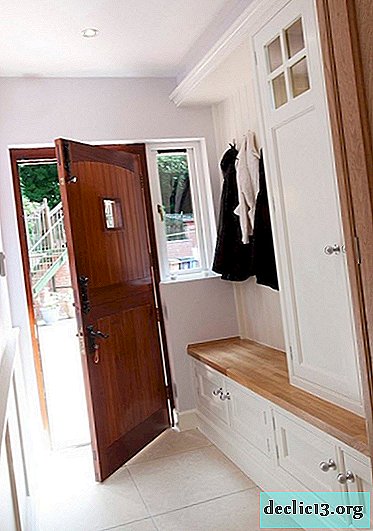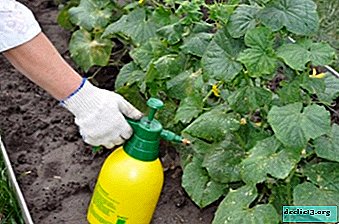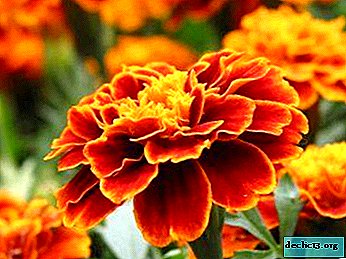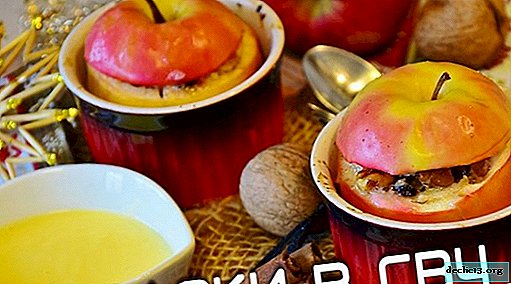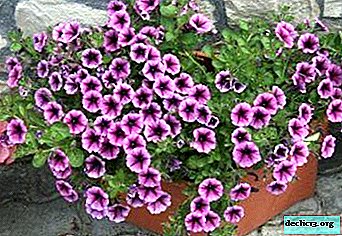What is a Lavinia rose, and how to properly care for this flower?
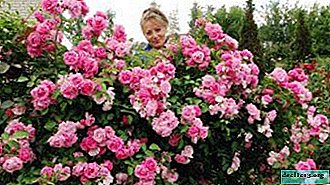
Lavinia climbing from Germany. It is considered the best modern type of climbing roses due to its beauty and unpretentiousness in care.
In satya, we will examine the rose visually in the photo, and also learn how to care for it, how to propagate.
We also learn how to properly grow this variety of flower in order to enjoy its flowering as long as possible.
Description
Has a clean bright pink shade of cup-shaped inflorescences with a bewitching aromaremotely resembling nutmeg, and large glossy leaves. A bud with slightly curved edges with a large number of petals, with full disclosure, the edges lighten a little, and the core remains saturated pink.
This variety is re-flowering, with a short break in the ripening of buds, so all summer the bush is literally strewn with beautiful double flowers. Strong shoots reach up to 3 meters in height and 1.5 meters in width.
Photo
Here you can see what this amazingly beautiful plant looks like.




History of occurrence
Bred in 1980 by Rosen Tantau by a German gardener. Every year, Lawinia won the hearts of lovers of climbing roses and managed to win the Syracuse Rose Society Show award, 1999.
Unlike other varieties
This type of rose is unpretentious to weather conditions, calmly tolerates light frosts and rainy weather, blooms plentifully continuously until the onset of cold weather. It has good immunity to most diseases of roses. Due to strong shoots, it can grow without support like a scrub.
Bloom
On average, about 7 flowers up to 9 cm in diameter are formed in the brush. On a large bush at a time you can observe up to 50 fragrant flowers with large juicy petals. Flowering time from May to September, with a warm climate, a small number of flowers can last until October.
An important point! The first buds need to be cut off, since a young plant gives a lot of strength to their development.Immediately after the rose fades do not rush to remove all the old buds. Leave the part before the onset of cold weather. It is not recommended to feed with nitrogen during flowering.This will ruin the quality and quantity of colors. After the buds appear, water the rose every 10 days.
Why doesn’t bloom?
This is observed in sick roses, with the wrong seat, with a large number of nitrogen additives, when pruning last year's vines.
Step-by-step care instructions
 Rosa loves to grow clean, so timely weeding is recommended. And it is better to mulch with any material that retains moisture, does not block the access of oxygen to the root system and prevents weeds from growing (peat, sawdust, expanded clay, overripe grass).
Rosa loves to grow clean, so timely weeding is recommended. And it is better to mulch with any material that retains moisture, does not block the access of oxygen to the root system and prevents weeds from growing (peat, sawdust, expanded clay, overripe grass).
- Shine. Rosa is a very photophilous plant and climbing species are no exception. The place should be sunny (southwest, southeast, south).
- The soil. The soil should be fertile, well loosened, with a small admixture of sand, humus, compost, clay, turf soil, you can also add special soil for roses. Acidic and alkaline soil will lead to diseases of the Lavinia rose.
- Landing. Experienced gardeners recommend planting Lavinia in May-June. All kinds of root stimulants are used in the spring. A seedling purchased in a container can be planted even in the summer. When planting a climbing rose in summer, it is necessary to moisten the hole well with water immediately before planting. It is better to plant a bush without an old earthen coma in the spring, so that there is time to take root in a new place before the onset of autumn.
- To begin with, we dig a hole 60-60 cm, at the bottom we fill up the feeding mixture from humus peat and a little sand.
- Next, the seedling needs to shorten the branches, up to about 20 cm in length, roots up to 30 cm.
- Next, we immerse the seedling in the pit with top dressing.
Pay attention to the roots, a healthy root system of white color, it is recommended to trim brown roots (dead).
- Now sprinkle on top with a good fertile mixture, compact so that there are no voids.
- Abundantly water the seedling.
- After the earth is absorbed, it is necessary to fill the earth.
- Deepening the root neck of climbing roses will give extra roots. After 20 days after planting, you need to carefully dig the soil from the bush.
- Temperature. The optimal rooting temperature is + 23 + 25 degrees during the day, +18 at night.
- Watering. Water the seedling immediately after planting once every 7-10 days with a bucket of water. The rose does not tolerate stagnation of water, the roots immediately begin to rot. In the heat and drought, rose bushes should be watered once every five days.
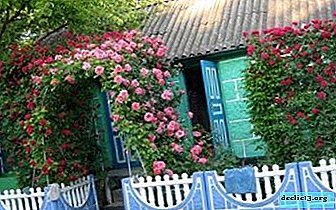 Top dressing. With the advent of young leaves, you can feed the beauty before flowering with nitrogen. In the first year after planting, you should not feed. And on the second one you can start to fertilize with liquid organic mixtures (mullein, overripe manure, compost) or complex mineral fertilizers. Many gardeners replace mineral supplements with ash. If the earth is poor in nutrients, it is worth feeding approximately every 10 days.
Top dressing. With the advent of young leaves, you can feed the beauty before flowering with nitrogen. In the first year after planting, you should not feed. And on the second one you can start to fertilize with liquid organic mixtures (mullein, overripe manure, compost) or complex mineral fertilizers. Many gardeners replace mineral supplements with ash. If the earth is poor in nutrients, it is worth feeding approximately every 10 days.It is also not recommended to feed the rose before hibernation, the exception is when the rose blackens, in autumn in especially rainy weather you need to process iron sulfate (we dilute a 3% solution of 300 g per bucket).
- Pruning. An essential part of caring for any rose is pruning.
- Sanitary pruning involves the removal of dried, diseased shoots. Trim at a slight angle, with a sharp secateurs or knife with a quick movement to a healthy kidney.
- Decorative pruning helps to cultivate a rose. Lavinia blooms only on last year's shoots, so they can not be cut.
- Late pruning allows the plant to get more nutrients in the winter (dormancy period of plants). The bush is overgrown with wild shoots, below the level of the inoculative place, such shoots need to be cut off by hand.
- Garter. Next to the plant, dig a wooden stake in the ground and secure the lash. You can use ropes, wire or special clamps.
- Transfer. It is desirable to transplant in the spring with an old earthen lump on the roots. The best time is autumn or early October. When transplanting, shoots are necessarily shortened by half.
- Wintering. It is very important to properly prepare the rose for winter, as part of the young shoots are frozen, especially if the bush is tall.
- With the onset of frost -5-7 degrees, we remove all the garters from the supports and carefully lay the bush on the ground, previously you can warm the bed with straw or peat.
- So that the bush does not rise, it must be carefully secured with wires or wooden stags.
- Next, cover the rose with spruce branches or agrofibre. It is very important that the rose under cover receives enough oxygen.
- With the onset of sustainable heat, the rose is returned to its original place.
Breeding
Spring ways
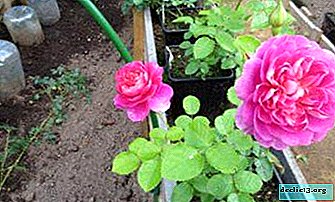 Lazy cuttings:
Lazy cuttings:- It is necessary to choose a healthy low-growing lash, very carefully make a few small incisions near the kidneys.
- Then we make a small groove with our hand and put the incised vine there. Cut off the vine from the bush is not necessary.
- Next, you need to give a little vine to the ground, for example, old scraps of bush, and sprinkle with earth.
- Water as usual.
Thus, by autumn, you can get several seedlings for propagation.
In open ground:
- It is necessary to cut out the middle of a healthy shoot with three living buds.
- The angle of the lower cut is 45 degrees by 0.5 cm from the kidney, the upper 90 degrees by 1 cm from the kidney.
- We leave no more than 5 leaves on the branches of the stem, and the last large one is cut in half, the bottom leaf on the seedling itself is completely cut off.
- The seat should be sprinkled with pre-scalded boiling water with sand.
- Dip the seedling in the root and stick into the moist soil.
- Pour and cover a sapling of a glass jar abundantly to create a greenhouse effect.
- The place should be sunny, but not in direct sunlight. The can needs to be lifted periodically for ventilation. When the plant is overgrown with good roots, remove the jar.
- In boiled water. Cuttings are prepared in the same way. Stand in a darkened place.
- Graft:
- At the root of the dogrose makes a T-shaped incision, the bark opens slightly and a healthy rose root is inserted into the pocket.
- Press tightly and wrap with a special film for budding.
- Sprinkle with earth 5 cm above the vaccination site.
- After a couple of weeks, the film needs to be loosened.
Autumn way
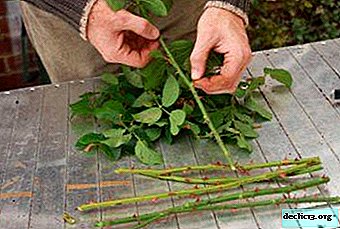 We prepare a stalk 10-15 cm long from a healthy whip. For autumn rooting (August-September), it is worthwhile to choose woody, well-ripened annual shoots.
We prepare a stalk 10-15 cm long from a healthy whip. For autumn rooting (August-September), it is worthwhile to choose woody, well-ripened annual shoots.- We put expanded clay on the bottom of a plastic bottle with holes, then a layer of a mixture of peat sand and garden soil 5 cm below the edge.
- Shed well with water.
- We stick the stalk and cover with plastic a bottle on top.
The optimum temperature is 22-25 degrees. Rooting occurs within 3-6 weeks.
Diseases and Pests
Of the pests found:
- spider mite;
- aphid;
- leaflet;
- thrips;
- saw cut saw.
Diseases include:
- gray rot;
- burned bark;
- powdery mildew;
- bacterial cancer.

 Top dressing. With the advent of young leaves, you can feed the beauty before flowering with nitrogen. In the first year after planting, you should not feed. And on the second one you can start to fertilize with liquid organic mixtures (mullein, overripe manure, compost) or complex mineral fertilizers. Many gardeners replace mineral supplements with ash. If the earth is poor in nutrients, it is worth feeding approximately every 10 days.
Top dressing. With the advent of young leaves, you can feed the beauty before flowering with nitrogen. In the first year after planting, you should not feed. And on the second one you can start to fertilize with liquid organic mixtures (mullein, overripe manure, compost) or complex mineral fertilizers. Many gardeners replace mineral supplements with ash. If the earth is poor in nutrients, it is worth feeding approximately every 10 days. Lazy cuttings:
Lazy cuttings: We prepare a stalk 10-15 cm long from a healthy whip. For autumn rooting (August-September), it is worthwhile to choose woody, well-ripened annual shoots.
We prepare a stalk 10-15 cm long from a healthy whip. For autumn rooting (August-September), it is worthwhile to choose woody, well-ripened annual shoots.



